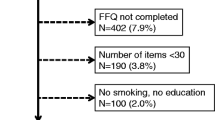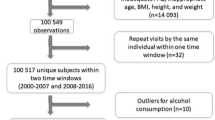Summary
Background
Diseases distributions are not the same all over France. As diet is an important determinant of health it is essential to determine whether there was still a diversity in food habits across French regions.
Aim of the study
We examined regional differences in dietary habits and nutrient intakes among French women born between 1925 and 1950 participants in the “Etude Epidémiologique auprès des femmes de l’Education Nationale” (E3N) cohort.
Methods
Data were extracted from self–administered dietary history questionnaires completed by 73024 highly educated, middle–aged women between 1993 and 1995. Canonical and cluster analyses were used to identify contiguous areas of homogeneous dietary habits spanning two or more of the 20 French regions. Dietary clusters were described relatively to the entire cohort mean.
Results
Eight dietary clusters were identified. The following food items were overconsumed: cooked vegetables in the Mediterranean, fish in the West, fruit in the South–East, and potatoes in the North. The following food items were under–consumed: fish in the East, fruit in the North, and potatoes in the South–East and Mediterranean cluster. Consumption of soup and fruit increased with age, while consumption of pork, horse meat and coffee fell with age. Ethanol intake was highest in the North and lowest in the South–East; the types of alcoholic beverages consumed also varied across clusters. Total energy intake, nutrient intakes, and the contribution of carbohydrates, fat and protein to total energy intake were similar across clusters. Intake of cholesterol and polyunsaturated fatty acids varied across clusters.
Conclusion
Dietary habits and alcohol consumption show marked regional differences in this population of middle–aged, highly educated French women. Changes in dietary behaviour with age involved few food items and were similar across clusters, suggesting that regional differences in food and beverage consumption persist.
Similar content being viewed by others
References
Haut Comité de Santé publique (2000) Pour une politique nutritionnelle de santé publique: Enjeux et propositions (French High Committee on Public Health: For a nutritional public heath policy in France: Stakes and proposals). ENSP, Paris (in French)
Babayou P (1996) Les disparitás régionales de la consommation alimentaire des ménages français (Diet regional disparities of the French households). CREDOC, Paris (in French)
Salem G, Rican S, Jougla E (2000) Atlas de la Santé en France: Volume 1: Les causes de décès (Atlas of Health in France – Volume 1: Causes of deaths). John Libbey Eurotext, Montrouge (in French)
American Institute for Cancer Research (1997) Food, nutrition, and the prevention of cancer: a global perspective. American Institute for Cancer Research/ World Cancer Research Fund, Washington DC
Clavel-Chapelon F, Van Liere MJ, Guibout C, Niravong MY, Goulard H, Le Corre C, Hoang LA, Amoyel J, Auquier A, Duquesnel E (1997) E3N, a French cohort study on cancer risk factors. Eur J Cancer Prev 6:473–478
Kesse E, Clavel-Chapelon F, Slimani N, van Liere M and the E3N Group (2001) Do eating habits differ according to alcohol consumption? Results of a study of the French cohort of the European Prospective Investigation into Cancer and Nutrition (E3N-EPIC). Am J Clin Nutr 7:279–280
Van Liere MJ, Lucas F, Clavel-Chapelon F, Slimani N, Villeminot S (1997) Relative validity and reproducibility of a French dietary history questionnaire. Int J Epidemiol 26:S128–S136
Lucas F, Niravong M, Villeminot S, Kaaks R,Clavel-Chapelon F (1995) Estimation of food portion size using photographs: validity, strength, weaknesses and recommendations. J Human Nutr Diet 8:65–74
Jambu M (1999) Méthodes de base de l’analyse des données (Basic methods for data analysis). Eyrolles, Paris (in French)
SAS/STAT User’s Guide (1999) SAS Institute Inc., SAS OnlineDoc®,Version 8, Cary, NC: SAS Institute Inc.
Babayou P, Volatier JL (1997) Les effets d’âge et de génération dans la consommation alimentaire (Effects of age and generation on diet consumption). CREDOC, Paris (in French)
Trichopoulou A, Costacou T, Bamia C, Trichopoulos D (2003) Adherence to a Mediterranean diet and survival in a Greek population. N Engl J Med 26:2599–2608
CNERNA, CNRS (1996) Alimentation et Cancer – Evaluation des données scientifiques (Diet and Cancer – Evaluation of scientific data). Tec & Doc Lavoisier, Paris (in French)
Working group on diet and cancer of the Committee On Medical Aspects of food and nutrition policy (1998) Nutritional Aspects of the Development of Cancer. Department of Health, Report on Health and Social Subjects 48, The Stationery Office, Norwich
Author information
Authors and Affiliations
Consortia
Corresponding author
Additional information
*M.Van Liere, C. Le Corre, L.Hoang, M. Niravong
Rights and permissions
About this article
Cite this article
Kesse, E., Boutron-Ruault, MC., Clavel-Chapelon, F. et al. Regional dietary habits of French women born between 1925 and 1950. Eur J Nutr 44, 285–292 (2005). https://doi.org/10.1007/s00394-004-0523-x
Received:
Accepted:
Published:
Issue Date:
DOI: https://doi.org/10.1007/s00394-004-0523-x




